Ritchie Priddy
Sustainability Director
American Energy Solutions
www.americanenergy.com
Steve Simonson
Partner, Supply Chain Consulting Services
Tompkins International
www.tompkinsinc.com
June 2012
Introduction
Sustainability is rapidly becoming one of the most important issues facing organizations today. In the near future, it could well become the defining issue.
Companies that are not prepared for the onslaught of new regulations, peer pressure, and de facto requirements and have not properly positioned themselves will fall behind. They will miss out on opportunities to succeed in this evolving aspect of business and public visibility.
Companies ahead of the curve are the ones writing the rules, cutting costs, avoiding some risks and passing on others, and winning the public relations battles. Some organizations are even committed to increasing profits from their sustainability measures.
This will become much more serious as businesses advance into a new phase in sustainability – one that will likely bring new pressures to take action.
Suppliers, or those supplied by others, need to be aware of how sustainability affects the entire supply chain. What are suppliers doing? Are they becoming more efficient? How does a supplier’s action impact the company’s image? What steps are suppliers encouraging companies to take? What image is being portrayed?
Why is sustainability so important today when there is little legislation and much of the public has not bought into climate change? And, to that point, there is not even an agreed-upon definition of sustainability.
This paper seeks to better define sustainability, its drivers, supply chain implications and future development.
What is Sustainability?
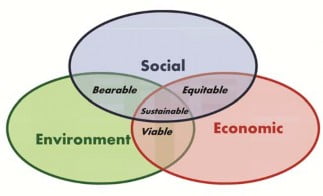
Sustainability is a broad term. It means different things to different people. The United Nations (UN) defines “sustainable development” as development that meets the needs of the present without compromising the ability of future generations to meet their own needs.
The sustainability industry has sprung up over the last decade. Its supporters have successfully “morphed” the definition from climate change (which many perceive as negative). Now, it is seen as an integral, inseparable part of the three- legged stool that comprises Corporate Social Responsibility (CSR), triple bottom line, or whatever term successfully ties a company’s economic, social and environmental activities together. It has been legitimized, and it is here to stay.
Corporate Social Responsibility
To be clear, man-made climate change has not been universally accepted as fact. However, it is rapidly coming to a point that it really does not matter if it is real. Perception is reality. Every piece of legislation, every regulation, and the fact that so many companies are taking action surely must prove it is real. Why else would naysayers be called “flat earthers” and vilified? Or, why are those who have taken action being put on a pedestal?
But, even CSR is too broad for this discussion. In this paper, sustainability is defined as “effectively managing energy risks.” And this impacts the entire organization on the demand side as well as the supply side. Why use energy as the de facto term? Simple, the combustion of energy is what produces the greatest amount of greenhouse gases (GHGs) responsible for changing (some say destroying) the climate.
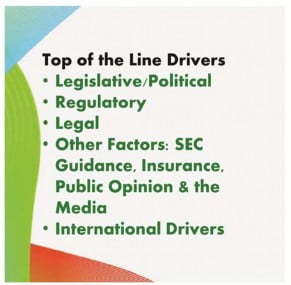
To simplify, for this paper sustainability is another, more acceptable term for climate change. Why tie in energy? Making energy usage more efficient is the single most important factor for lowering emissions. Efficiency transcends the entire organization. Efficient purchasing strategies are as important as usage. It’s sustainable. It’s sound risk management. It’s that straightforward – for those willing to listen. For those who don’t, beware.
There will be winners (and losers) in sustainability. In fact, there are already a few of both. What are the characteristics of the winners? How do they position themselves to stay out of the weeds where the debate is intense and far from unsettled without being labeled fear-mongers?
American Energy’s research has found a few common traits of companies that have taken actions. The primary common trait is that those who have taken action recognize a changing world. To get a better understanding of these changes, they do what many people do: They look to see which way the wind is blowing. Some go further and conduct an in-depth analysis to determine just how serious their efforts should be.
They understand that climate change is an extremely polarizing issue that must be handled appropriately, lest they lose control of the message. Yet, they also understand that there is a danger of going too far. These companies, and others, may be looking for the direction to become clearer based on the outcome of elections, political decisions or regulatory directives. Regardless of the political and regulatory environment, sustainability is not going away.
The best early action any company can take is to identify and study the primary drivers – legislative/political, regulatory, legal, SEC guidance, insurance, public opinion and the media, as well as international drivers. Look at them holistically and determine a plan of action.
Legislative/Political Drivers

This paper maintains an American perspective on sustainability, but an international view cannot be ignored.
Nationally, the primary movement is through Executive Orders, the Department of Defense (DOD), the Securities & Exchange Commission (SEC), and the Environmental Protection Agency (EPA). These all fall under the executive branch.
The most important executive order is 13514, signed by President Obama in 2009. It requires all federal agencies to annually report their energy usage and emissions on a publically accessible web site (www.whitehouse.gov/assets/docu ments/2009fedleader_eo_rel.pdf).
Section 13 of this executive order contains the key issues for suppliers. It includes a recommendation to require the federal vendor and contractor community to track Scope 3 emissions related to the supply of products and services to the government.
Scope 1 and 2 emissions are easy to calculate, and are increasingly being required by many companies. Scope 1 emissions are direct GHG emissions from sources that are owned or controlled by the company. Scope 2 emissions are GHG emissions from the purchase of electricity by the company. Scope 3 emissions include all other indirect GHG emissions. This includes emissions that are a consequence of the activities of the company, but occur from sources not owned or controlled by the company, such as supplier emissions, business travel, and the use of sold products and services.
Why is this executive order important to suppliers? A follow-up report issued by the General Services Administration recommends that the federal government begin to use contractor GHG information as an evaluation tool. In other words, companies that do not report GHGs could be de-listed as a vendor.
The shift in DOD policy, beginning with the 2008 National Intelligence Assessment, laid the foundation for the executive order. Subsequent DOD reports identified climate change as a national security threat. In fact, the DOD found that “climate change, energy security and economic stability are inextricably linked.”
Why is the DOD action so important? Until 2008, legislation was aimed primarily at the government sector. But, the shift at DOD really opened things up to include the private sector, largely through supplier reporting.
Note that the DOD policy shift began prior to the Obama administration, and it is just one more piece in a long line of environmental changes that were already underway. But, this was a monumental event in terms of spurring action by the private sector.
State actions – especially legislation – are important. In some areas, these actions are actually more stringent than anything the federal government is currently requiring.
Indeed, many states have adopted new policies recognizing energy efficiency (EE) as the first fuel, and a vital part of system planning. That means that before a new generation plant can be built, all practical EE actions must be exhausted. System planners must accurately determine how much EE – and load shedding (demand response) – they can expect. And, when called upon it had better be there. It is important to remember that EE is a permanent reduction in load, while demand response (DR) is a temporary reduction in load.
Regulatory Drivers
The most significant regulatory requirements on the federal level, besides the DOD, include the various EPA rules. For example, there continues to be a fuss over the Cross State Air Pollution Rule (CASPR) and other EPA rules and announcements that impact generation plants, particularly coal plants.
Many energy industry analysts believe that both will lead to fewer new power plants and/or the removal of thousands of megawatts (MWs) from the grid. This will lead to significant shortfalls as they relate to power reserve margins. At the same time, the government states that these rules will save lives, and the impact on system reliability will not be significant. The truth is probably somewhere in between.
Why is there uncertainty about the rules? There are several reasons. One reason is that the nation’s electrical infrastructure is in bad shape. In fact, the Electric Power Research Institute (EPRI) estimates it would take $100 billion and 10 years to update the grid. Another reason is that environmental concerns are prohibiting building new generation plants and transmission lines. These two reasons, in particular, have led to uncertainty in the industry, and uncertainty leads to inaction.
The primary method to meet rising demand in the next 1-5 years is through demand side management (DSM). That is, reduce peak demand and lower usage. Traditionally, utilities have been responsible for doing this, but history shows they have not been all that successful. However, things are different now. If utilities do not meet their efficiency and environmental obligations, they are penalized. This is the primary reason why DSM budgets have been growing the last few years.
Regulators realize that more must be done. Many commissions, governors and even mayors have implemented new rules such as benchmarking and public disclosure that require public and (in some cases) private companies to annually disclose their energy usage and emissions. For a list of all of the disclosure rules in the U.S., see www.buildingrating.org.
At the end of the day, the intent of legislation and regulation is to force end-user behavior change. But, history shows that the only thing that influences long-term behavioral change is sustained, high prices.
Legal Drivers
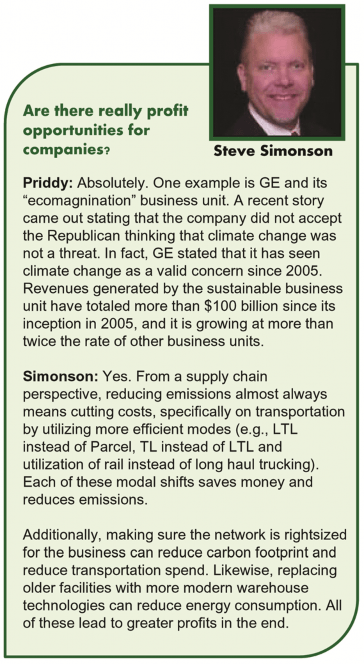
The legal side of sustainability is probably the biggest concern for most companies. The cost of litigation is high; various courts have ruled inconsistently; and the risk of future liability requires companies to remain vigilant.
The lawsuits that many executives fear most are public nuisance cases. A public nuisance is a common law tort that imposes liability on an individual or entity that interferes with a public right to health or safety, for example. It has been used successfully in tobacco and gun litigation, and many fear that climate change suits could eventually be defined as public nuisance. Under this scenario, a generation plant or a large energy user may be sued by its neighbors, or even neighboring states, for contributing to the intensity of storms, or for emissions that drifted into the surrounding area, and more. If found guilty, the offending parties could face enormous costs – not the least of which is the cost of litigation. Just fighting the lawsuit(s) will be costly, and those costs will be passed on to the consumer in one form or another.
Perhaps the most well-known nuisance case in the last year or so is American Electric Power vs. State of Massachusetts. The Supreme Court heard the case and ruled that climate change-related cases are best left to the legislative and political branches. The Obama administration supported that viewpoint and claimed all along that the EPA was taking action.
However, opponents of that ruling claim that the EPA has failed to take action in a timely manner and many have filed suit to force their hand. This, combined with the presidential election year, spurred the EPA to take action to placate environmentalists, while also delaying implementation to please generators, and to keep power prices lower in the short term.
Climate change litigation is fast emerging as the “new frontier of law.” And, that fear is prompting action. To get a good understanding of just how important litigation is, view this chart: www.climatecasechart.com.

Other Factors
SEC Guidance
The 2010 SEC guidance document on climate change reiterated that existing regulations were enough to require all publically traded companies in the U.S. to report in their financial statements all climate change-related risks and opportunities.
The document contains many references to materiality, resulting from indirect and direct consequences of climate change. All are ill-defined. But, the requirement is there. Considering that a C-level executive signs these documents and can be held personally responsible for inaccuracies, the need for accurate and auditable disclosure is clear. For anyone required to report, be sure that corporate risk management and legal departments are involved in the response.
Insurance
Every time a bad storm or an outbreak of tornados, or flooding occurs, climate change will sooner or later be blamed. Part of that is just the nature of the media. But, part of it could be more episodes of intense weather – at least since record keeping began some 100 years ago.
Dr. Robert Hartwig of the Insurance Information Institute (www.iii.org) has valuable information on this, and there are not many options when it comes to record keeping apart from insurance companies.
Dr. Hartwig’s conclusions show:
-
The frequency and severity of catastrophes seem to be increasing.
-
In recent years, non-tropical thunderstorms and tornados have caused most insured damage, supplanting tropical storms/hurricanes.
-
2011 was an especially expensive year for insured losses, and 2012 is starting off similarly.
-
The US had 99 federal disaster declarations last year – the most ever.
Note that the insurance industry has tremendous influence on regulations and policies. As a whole, it is one of the largest investors in commercial real estate. Its exposure to rising sea levels and increasingly intense storms is enormous – one reason why it has become much more active in pushing for the adoption of stricter building codes, etc.
Public Opinion & the Media
Concern about global warming has never been shared by a majority of the populace, but when the light of the media shines on any event, it influences behavior. A good exercise to prove this requires one to identify what types of stories are covered, particularly leading up to and immediately following international meetings on climate change.
The point here is that every company must understand, or at least acknowledge, the influence the media has on public opinion, politicians and eventually company behavior. Every company also needs to understand that the folks who are pushing sustainability the hardest are media savvy and many tend to think like media. They influence what topics are covered and how they are presented.
International Drivers

The UN sponsors international climate change talks, and last year’s Durban, South Africa Conference of the Parties (COP 17) was viewed by many as a failure. After all, there was no binding legal agreement to take the place of the expiring Kyoto Protocol, and several countries are backing away from their earlier commitments.
That meeting has been followed by others, including the Rio + 20 UN Summit on Sustainable Development in June. In 1992, the first such summit, also held in Rio, brought the Kyoto Protocol. Kyoto expires in 2015. No binding replacement has been accepted by more than just a handful of largely non-industrialized countries.
Upon a closer look, Durban was really not a failure at all. In fact, the US Department of State envoy on climate change expressed that “years from now, the world may look back at COP 17 as a pivotal moment.”
It was not a failure because of the reporting aspect. The last-minute agreement calls for greater transparency by all countries. This means, ultimately, that a company’s energy and emissions information, along with the methodology and verification used to determine emissions must be verifiable – it better be good quality and auditable.
The Rio outcome was similar. Increased calls for reporting means that as more corporations provide disclosure in some form (and the number of companies reporting is growing rapidly), the more influence they have to change the way the economy works.
Realistically, though, most of the action at these summits really does not take place in the legislative sessions. Rather, these gatherings tend to bring in a lot of famous and influential personalities who want to, and have, influenced the outcome in side sessions to promote their own agendas. These personalities are either protecting their own companies and industries from draconian changes or embracing these changes to show themselves as responsible and set apart from their peers. In other words, they help themselves to competitive advantages.
The New Phase of Sustainability
Phase I (1970s – 2007): The world has entered a new phase in the evolution of sustainability. The first phase was recognition of a problem (i.e., global warming). That term did not resonate as much as the proponents had hoped. It was subsequently repositioned as climate change, which was later repositioned as sustainability.
No one can pinpoint the exact date that concern over the issue began, but it came out of the environmental movement from the early ’70s. It was former British Prime Minister Margaret Thatcher, however, that is largely responsible for bringing it to the forefront during her 1988 re- election campaign when she stated that there is a global climate problem. (She later backed off her initial enthusiasm because she believed that the movement had been hijacked.)
Phase II (2007 – 2011): The second phase began with the controversial Fourth Assessment Report from the UN Intergovernmental Panel on Climate Change (IPCC), released in 2007. In the report, the panel fervently warned that climate change is coming and action must be taken to mitigate the damage it will cause. But there was controversy surrounding the report as several scientists were found to have manipulated data and skeptics were ostracized. Despite these and other problems, the Fourth Assessment is the foundational document of virtually every action taken by the federal government on climate change.
Phase III (2012 – ?): The first report of the next assessment is due out in 2013, and American Energy recently reviewed a primer that is quickly being interpreted as the beginning of a new phase in sustainability.
The third phase has been sputtering along for a while, but the release of an IPCC earlier this year has solidified it. In late March, the IPCC released a 594-page assessment report stating that nations need to act now, “because increasingly extreme weather is already a trend.”
The report’s title drove home the point: Managing the Risks of Extreme Events and Disasters to Advance Climate Change Adaptation. In all fairness, the executive summary of this report was released in November of 2011. The number of news stories written about this report is mind- boggling, and they uncover a good understanding of proponents’ tactics. This is especially true leading up to the Rio + 20 summit.
The tone has changed from mitigation (i.e., changing the risks associated with climate change) to adaptation (i.e., managing the risks). In other words, climate change is here and the time for action is now. With each passing bout of severe weather, the demand for action will intensify.
Industry Response
Despite the lack of clear directions, the smartest companies are taking actions. Most are taking actions in order to manage risks, increase efficiency and reduce operating costs. Some see profit opportunities; some want to be good corporate citizens; and others want to influence coming regulations. Virtually all take advantage of the public relations opportunities.
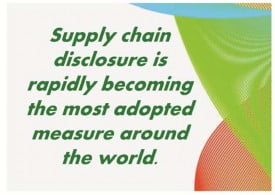
The primary actions taken thus far include the publication of annual sustainability reports (sometimes called CSR reports, or something similar) that catalog the types of actions taken by the company as they relate to the environment over the past year.
Virtually every sustainability report contains energy and emissions reduction goals. All of these actions begin with benchmarking current usage and emissions. The next step is typically energy efficiency upgrades of their own facilities, though many companies have not yet taken sufficient steps. Efficiency upgrades will be a boon for such companies, but it is important that those considering such moves fully explore the costs, paybacks, and opportunities.
Publically traded companies are now required to report in their annual financial statements all climate change-related risks and opportunities. But many companies have gone further, particularly in two areas: Public disclosure and supply chain disclosure.
Why are these two areas so important? Public disclosure requirements, such as those found in New York City, directly impact the value of building assets. The higher the score, the higher the asset’s value, rent and demand. There are a growing number of cities and states that require public disclosure of energy usage and emissions. Most require annual submissions to the regulatory body.
The federal government, which is the largest purchaser of goods and services in the world, already requires each agency to document and report its energy usage and emissions, and to prepare plans to reduce both. It is now considering requiring all suppliers to report their usage in order to remain on the government bid list.
Supply chain disclosure is rapidly becoming the most adopted measure around the world. Most companies have come to realize that the great majority of their emissions are not from their own operations, but rather from their suppliers’ operations.
By requesting (and then requiring) suppliers to report energy use and emissions, it pushes costs and risks downstream.
There is significant evidence to suggest that the adoption of supply chain reporting has more weight than any international agreement. If suppliers do not report their emissions, they risk being de-selected. No company – regardless of where they are located – wants that.
A growing number of reporting proponents are pushing for third-party verification, which is more expensive and results in more in-depth reporting. Perhaps that is a good thing, especially if there are specific mandates and requirements for reporting, and it will move the adoption of a common standard forward.
The Cost of Non-Compliance
It is not difficult to see what happens to companies that do not embrace climate change (i.e., sustainability), as evidenced by the following statement posted April 6, 2012 on the Think Progress organization website (Nucor Exposed: Corporation Bankrolling Climate Denial Claims ‘Global Warming Not Taken Lightly).
“According to leaked documents, Nucor Corporation (NUE), one of the largest steel producers in the United States, is the top named funder of the Heartland Institute’s climate denial efforts, which consist of smearing scientists, distorting climate science, and teaching children that ‘whether humans are changing the climate is a major scientific controversy.'”
“Nucor’s support for climate denial is in conflict with the company’s branding campaign as an environmentally friendly corporation, deeply concerned about ‘issues concerning climate change and greenhouse gas emissions.’ Nucor has called itself a ‘Green Company’ and even registered the slogan ‘It’s Our Nature’ in order to promote its ‘promise to be environmentally conscious’ and its practice of primarily using recycled scrap metal.”
“Additionally, Nucor has a spotty environmental record. In December 2000, Nucor paid nearly $100 million to settle an EPA lawsuit that alleged Nucor polluted groundwater and failed to meet air pollution limits. Based on Nucor’s 2006 air pollution emissions, the University of Massachusetts’ Political Economy Research Institute ranked the company the 24th most toxic large corporation in the United States.”
Is it any wonder that companies are actively embracing sustainability and trying to keep their name off the denier list?
The Future of Sustainability
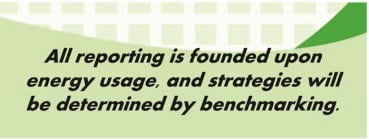
Now that climate change has been incorporated into CSR, the focus is turning to an integrated view of a company. After all, it is becoming increasingly difficult to separate a company’s economic, social and environmental aspects.
The drive for increased reporting – including Scope 3 emissions – will continue to move forward. While there are not yet any commonly accepted standards, several protocols and methodologies currently exist.
The critical takeaway is that all reporting is founded upon energy usage. Determining emissions is impossible without knowing energy consumption. If clean companies are determined by energy consumption and emissions, the most important and immediate steps are benchmarking current usage and emissions. Strategies will be determined by benchmarking.
Energy efficiency upgrades are the single most effective way to lower emissions. Side benefits include lower energy costs, better competitive positioning, and a public relations win.
The key indication of success is the quality of a company’s measurement and verification procedures. Therefore, expect very stringent protocols to be introduced with special emphasis on measuring Scope 3 emissions – which include supply chain emissions.
The key takeaway here is the adoption of much stricter standards, such as the Greenhouse Gas Protocol Corporate Value Chain (Scope 3) Accounting and Reporting Standard, released in October 2011 by the World Resources Institute. To obtain a copy of this standard, see www.wri.org.
Key Questions & Answers
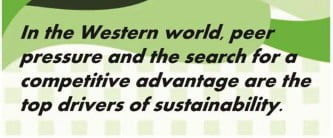
With no current action required, why should companies take action? In the Western world, peer pressure and the search for a competitive advantage are the top drivers of sustainability. Being a low-cost provider by cutting energy usage and lowering emissions certainly leads to competitive advantages.
How will reporting requirements evolve? Integrated reporting will eventually become the norm. It will bring together financial, environmental, social and governance information in a single, comprehensive report. This will be in addition to financial reporting, but some proponents believe it may eventually take their place.
How far is too far? The problem for climate change proponents is that it is happening too slowly to garner much support. After all, human nature is such that unless it is directly impacted over a short period of time, the long-term consequences may be dismissed.
So, proponents change tactics and reposition it every few years. This iteration, which is now clear with the release of the latest IPCC report has moved from “it’s coming” to “it’s here.”
Gasoline prices are a good barometer. At what price point does gasoline become too costly, too disruptive, and too politically unacceptable? Already, the administration has called for additional, but limited drilling and has released oil from the Strategic Petroleum Reserve (SPR). In all fairness, the administration claimed it did it for several reasons, but the intent was clearly to lower gasoline prices in the short term.
A downside is that if climate change is oversold to the point that the public must cut back on energy usage, it can damage the economy, not to mention the individual’s lifestyle. With power reserve margins shrinking in many key areas, and reliability questioned, serious demand side management (DSM) efforts must be made, or risk power shortages. Anyone who has lived through a late summer hurricane knows the usual reaction to not having power. No politician wants to get those calls.
What happens if the courts, or the executive or legislative branch, rule that the severity of storms is influenced by energy use and high emissions? This is unlikely right now, but as climate change acceptance grows – and a lot of that has to do with how the media frames the issue – then more politicians, lawyers and judges will be pushing for liability assessments and claims against those that are perceived to be responsible.
Perhaps the best response that can be taken now is to thoroughly investigate one’s own energy usage and emissions, document them, and try to get ahead of the game by working to reduce both.
How does sustainability affect the supply chain? From an operational standpoint, sustainability in the supply chain is an ongoing problem that companies face. Lowering emissions by reducing transportation activities is not only good for the environment but can also be good for the bottom line. Major points to consider are:
-
Packaging strategy – By decreasing the product packaging size, companies can reduce overall raw material and more efficiently utilize storage and transportation.
-
Network/transportation analysis – Through analyzing their current network and transportation design, strategies can be developed to consolidate inbound logistics, improve outbound efficiency and maximize the use (or reduce the number) of facilities.
-
Warehouse design – Natural lighting, conveyor design and more efficient use of space can optimize the warehouse.
About Tompkins International
Tompkins International transforms supply chains to help create value for all organizations. For more than 35 years, Tompkins has provided end-to-end solutions on a global scale, helping clients align business and supply chain strategies through operations planning, design and implementation. The company delivers leading-edge business and supply chain solutions by optimizing the Mega Processes of PLAN-BUY-MAKE-MOVE-STORE-SELL. Tompkins supports clients in achieving profitable growth in all areas of global supply chain and market growth strategy, organization, operations, process improvement, technology implementation, material handling integration, and benchmarking and best practices. Headquartered in Raleigh, NC, USA, Tompkins has offices throughout North America and in Europe and Asia. For more information, visit www.tompkinsinc.com.
About American Energy Solutions
Founded in 1996, American Energy was structured to address the needs of commercial consumers interested in aligning energy management strategies with their long-term business goals. Using a proven comprehensive, step-wise approach, from current-state benchmarking to turnkey implementation, American Energy offers custom solutions for national clients in a wide variety of industries. The American Energy team, headquartered in Leawood, Kan., possesses more than 150 years of combined expert energy industry experience. To learn more, visit www.americanenergy.com.
Contact:
Ritchie Priddy
Director, Sustainability and Technical Services
American Energy Solutions
rpriddy@americanenergy.com
Steve Simonson
Partner, Supply Chain Consulting Services
Tompkins International
ssimonson@tompkinsinc.com


